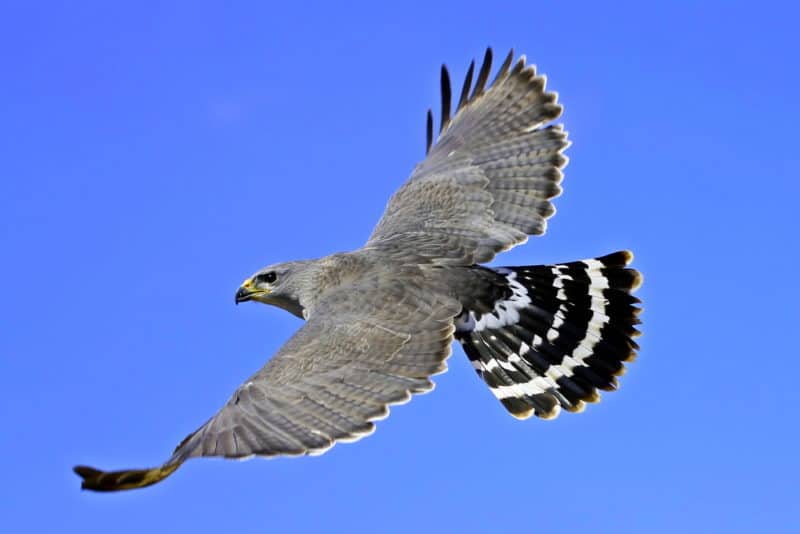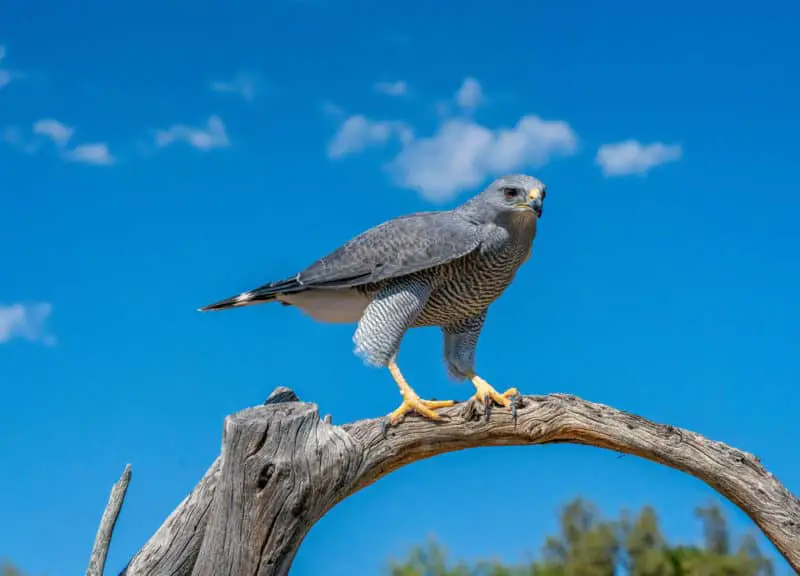Scientific Name- ” Buteo plagiatus“
The Gray hawk also goes by the name Mexican Goshawk. Although they are now in the buteo genus, they were formerly placed in the genus “Asturina“, and their former taxonomic classification was “Asturina plagiata.” In 2005 the Astrina and Buteo genera were merged, and the scientific name for the Gray hawk became “Buteo nitidus“.
In 2012, the Gray hawk was split into two different species due to minor differences in coloration and vocalization. The first species is the Gray-lined hawk which lives from southern Costa Rica south to Northern Argentina. The Gray-lined hawk retained the original scientific name of “Buteo nitidus“. The second species is the Gray hawk that we’re talking about. It lives from northern Costa Rica up into the southwestern United States. It has the scientific name of ” Buteo plagiatus“.
There has been some disparity in opinions between ornithologists on whether they should be placed in the Asturina or Buteo genus until 2013, when they were genetically proven to be buteo hawks. Source
Gray Hawk Characteristics
Gray hawks are solid pale grey on top. This transitions to fine bars on their chests and the bottom side of their wings that are grey and white. Additionally, they have black tails with three white bands. As for facial markings, they have white cheeks and white above the eye. This is separated by a black streak through the eye.
Their legs and talons are yellow to orange.
Juvenile Gray hawks are mottled brown.
In size, adult gray hawks are 18–24 inches (46–61 cm) in length and weigh 13.8 to16.8 ounces (391to 475 grams).

Gray Hawk Range
Gray hawks live in North and Central America. Their range begins in Texas and southern Arizona in the north.
Gray Hawk Arizona
There are summertime populations of Gray hawks that migrate south for the winter in Cochise, Santa Cruz, and Pima counties in Arizona.
Gray Hawk Texas
There are also summertime populations of gray hawks in Brewster, Terrell, and Val Verde counties in Texas. Additionally, there are year-round populations of gray hawks in Cameron, Hidalgo, Starr, and Zapata counties in Texas.
South of the United States, the range of the Gray hawk extends down through Mexico, Guatemala, Belize, El Salvador, Honduras, and Nicaragua to northern Costa Rica for its southern boundary. Gray hawks from northern Sonora only inhabit that range during the spring and summer breeding season. They migrate further south for the winter.
Gray Hawk Habitat
Look for Gray hawks along forest edges, especially near riparian zones. In the United States, these birds prefer the cottonwood and willow trees along watercourses in the southwest desert. They also live in mesquite forests, along the edges of clear-cuts and around agricultural ground.
Gray Hawk Diet
Gray hawks eat a variety of reptiles, such as lizards and snakes. They also eat small mammals such as rodents, bats, and rabbits. Their diet will also include small birds and large insects such as grasshoppers.
Gray Hawk Behavior
Gray hawks hunt by soaring high above the surrounding area, but more often than not, it is a perch hunter. It will perch beneath the canopy of a tall tree and wait for prey to come by. If one perch is unsuccessful, it will move on to another. Another technique that they employ is to circle low over the treetops, scanning for movement of prey animals.
They are impressively swift and agile in flight and can pick their way adeptly through the tree branches to pick off fast-moving prey such as squirrels or lizards.
Gray Hawk Calls
When you’re in the woods, you might hear their telltale three-note keeaww vocalization that sounds quite a bit like a scaled-down version of a Red-tailed hawk. This call is used throughout the breeding season to give a warning to intruders in their territory and also to advertise to potential mates.
These birds also have a single-note alarm vocalization that a female might produce if there is an intruder encroaching too close to her nesting site. Males also make this call when they are in conflict with one another. Both sexes also make this one-note call as a sign of excitement during the begging for food by nestlings, prey exchange, or mating. Source They use this call all year round.
Gray Hawk Courtship And Mating Behavior
Gray hawks are monogamous. During the breeding season, they perform courtship displays. In a similar fashion to a lot of other raptors, these birds perform flight displays when courting. For Gray hawks, this involves a steep closed-winged dive followed by an upward open wing glide. Males and females both engage in this. They may turn sideways or completely inverted. They also occasionally cross paths at close distances during the steep dive. The male also calls to the female during these courtship flights.
Nesting Behavior
Gray hawks construct their nests in the outer branches in the upper half of trees. Unlike most other raptors, they do not build their nest close to the trunk. Both the male and the female contribute to the construction of the nest. However, they have separate duties in the nest’s construction.
The male selects the nest site and builds the nest base. After the male has completed his portion of the construction, the female builds and shapes the remainder of the nest, including the bowl of the nest.
They mainly use leafy twigs that break off from live trees for nest material. When they are in areas with cottonwood trees, cottonwood twigs are their first choice.
Their nests are usually around 20 inches in diameter and 4 inches deep. They line the bowl of their nests with greenery and strips of bark.
Their clutch size runs between 1 and 4 eggs. The female does the incubating of the eggs. While she’s doing that, the male provides her with food.
The incubation period for Gray hawks is 32 to 34 days. The chicks are born altricial. It takes 6 weeks for them to fledge. Both males and females take 2 years to reach sexual maturity.
Also See
Take time to take a look at the other posts we have on Buteo hawks.
Recent Posts
The only venomous snakes in Washington State are Northern Pacific Rattlesnakes. The Northern Pacific Rattlesnake (Crotalus oreganus oreganus) is a sub-species of the Western Rattlesnake. Anyone...
Skunks are not classified as true hibernators. But they go into a state of torpor when the weather gets cold. Skunks are light sleep hibernators, along with opossums, bears, and raccoons. ...

